Triumph Street Triple R vs. Ducati Streetfighter 848
Last year was an exciting year for motorcycle enthusiasts. Three of the four Japanese manufacturers released updated literbikes, Kawasaki an all-new ZX-14R and Ducati its groundbreaking 1199 Panigale. In the testing that ensued, however, none of these bikes had us grinning as much as the unmentioned Triumph Daytona 675R and Ducati 848 EVO Corse SE, two bikes that were arguably less innovative, but drastically more charismatic. Was it by chance, or by design, then, that we’ve all but replicated that test this year, only this time around supplanted the supersport models for their equally entertaining naked-bike counterparts, the Triumph Street Triple R and Ducati Streetfighter 848? Hint: we don’t believe in coincidences.
The Street Triple’s and Streetfighter’s design briefs meant that this year’s twin vs. triple test would invariably differ from last year’s up-spec middleweight comparison. The track was bypassed, for example (although after testing both these models in myriad conditions, we’ll agree that they’d hold their own on any roadcourse), and instead of the usual day ride through the canyons we opted for an overnight ride to Morro Bay, CA. Both the Triumph and Ducati are intended to be versatile — to play the role of two, maybe three bikes — and what better way to find out which manufacturer designed the better naked bike than to invite both on an all-encompassing 500-mile roadtrip? Whichever bike we could still manage to enjoy by the end of the adventure would surely be the better option.
Some of you may be noting that we chose to compare the up-spec version of the Triumph Street Triple instead of the standard model. There are two reasons why we’ve decided to do this: one, the $9999 R model is just $600 more expensive than the standard model, thus we figure the majority of people interested in the Triumph will automatically opt for the R model, which is equipped with fully adjustable suspension and stronger brakes that, quite frankly, are worth in excess of $600. What’s more, the Street Triple R, even with its higher price tag, is still $3296 cheaper than the $13,295 Ducati, thus there are no reasons to exclude the R model from a cost point of view. For those of you who are more interested in the standard model, we’ve included a first-ride review on that bike, which can be found on page 44.
MV Agusta aficionados will also notice that this test is minus an MV Agusta Brutale 675, which we would have loved to include in this comparison, but were unable to procure prior to our ride. Keep your eyes peeled for a separate review on that model in the coming months.
The Ducati Streetfighter 848, which was featured in a first-ride report a little over a year ago (“A Tamed Fighter,” January ’12), is intended to be a less aggressive, more user-friendly naked bike than its brawny predecessors, the Streetfighter 1098 and Streetfighter S. Interestingly enough, for 2013 it will carry the Streetfighter flag alone, as Ducati has decided to no longer sell either of the larger-displacement models.
Aside from its striking looks, the middleweight Streetfighter has little in common with its extinct kin. Showa suspension has been jettisoned for Marzocchi and Sachs components, for instance, and the bigger bike’s arm-stretching engine has been replaced by a less-intimidating Testastretta 11° mill. Actually, scratch the words less-intimidating, as that’s hardly a proper description for a middleweight engine that still produces 112.9 horsepower at 9900 rpm and 60.5 foot-pounds of torque at 9500 rpm. The lively twin covers the quarter mile in 10.72 seconds at 129 mph. The Street Triple R, for comparison, covers the same distance in 11.13 seconds at 124 mph.
The Ducati’s power advantages in this comparison are unfortunately curtailed by its heft; the overweight, 443-pound Fighter is an unimpressive 30 pounds heavier than the 413-pound Street Triple R. The difference isn’t well concealed either, and can be felt the second you throw a leg over the pudgy supermodel. The bike’s also got a tall six gear, either for improved fuel economy, engine longevity or reduced vibrations at highway speeds, which hurt it in our roll on tests; it went from 80-100 mph in an elongated 4.91 seconds, whereas the Triumph covered the same gap in just 3.93 seconds.
The SF 848’s ergonomics don’t help matters and are best described as aggressive, despite the bike having a 20mm-taller handlebar than the larger Streetfighters. The 33-inch-tall seat feels about as comfortable as a two-by-four come day’s end, and the one-piece handlebar (which is narrow and leaves you clinching the grip ends) bows at the ends, which puts an unfavorable amount of weight on your wrists. The problems trickle down to the footrests, which are poorly knurled and become extremely slippery in the wet. In the Ducati’s defense, the gap between the seat and footrests is some 18mm longer than the same gap on the Triumph, meaning that the Streetfighter is more comfortable for taller riders over the course of a longer ride.
The Ducati’s surplus of low-end torque means that you have to continually remind yourself of how nice it is to have a motorcycle license. Let your guard down for just a second and the bike will burst off the line in a one-wheel portrayal of a good time. It’s not all fun and games around town, however. We grew weary of the bike’s stiff clutch lever for instance, and also of the Streetfighter’s imperfect fueling at low rpm, which literally halts all forward momentum unless you drive the engine past 3500 rpm with absolute aggression. The Brembo brakes have plenty of power, so getting slowed down for the next stoplight isn’t a problem, but the front brake lever is equally as stiff as the clutch and frays your forearm well before the Triumph’s Nissin binders do.
The mini fighter is palatable in the canyons, not only because you’re using the levers less, but also because its softer, 75 N/mm spring (the 1098 ran an 85 N/mm spring) absorbs bumps with aplomb, plus the bike’s 1.1-degree-steeper rake (compared to the 1098) means steering is light enough to keep you from working too hard through a right-left-right transition. At full lean, the Streetfighter feels a bit less composed than the Triumph, but still settled enough to keep expert riders satisfied at a heightened pace.
As far as rider aids go, we prefer the Triumph’s switchable ABS over the Ducati’s eight-level traction control system. The Ducati’s system works well, mind you, but in the many conditions that we rode, we simply found ourselves relying on the Street Triple’s anti-lock brakes more than the Ducati’s traction control. The rocker switch on the left side of the handlebar, which is used to manipulate the system’s settings, takes more time to figure out than is offered by a normal stoplight, meaning we typically just gave up on the system and rode the bike in whatever setting it was in. In most cases that meant the system was off. Lo and behold, we survived to tell you the story.
Although we wrote about the 2013 Triumph Street Triple R’s updates in a previous issue of the magazine (Late Braking, January ’13), we’d yet to throw a leg over the motorcycle prior to this test. As a recap, the Triumph features a lighter, all-new frame that’s constructed from eight pieces rather than eleven; a high-pressure die-cast rear subframe that’s lighter and narrower; a low-mount exhaust, which lowers the bike’s center of gravity; a lighter rear wheel; one-piece cast aluminum (rather than steel) swingarm; and adjustable swingarm pivot. In addition to these changes, the bike also has a steeper 23.4 degrees of rake, longer 95mm of trail and 52/48-percent weight bias, which is more front-end partial than last year’s 49/51-percent weight bias.
The Street Triple’s engine is mostly the same, hold for new throttle bodies and recalibrated EFI settings. When strapped to our SuperFlow dyno, the mill produced 94.4 horsepower at 12,000 rpm and 44.6 foot-pounds of torque at 9300 rpm. And while that gives the Triumph an 18.5-horsepower disadvantage in this comparison, it’s impossible to ignore the bike’s perfectly straight power curve, which puts the Ducati’s potholed curve to absolute shame at all rpm. Power in any number of environments isn’t described as overwhelming, but Kento notes that, “I was never really left wanting more,” which says a thing or two about the Triumph’s engine performance.
The Street Triple R’s ergonomics are characterized by a reasonably shaped seat that’s also more comfortable than the Ducati’s saddle. The reach to the handlebar is 24mm shorter than the reach to the Fighter’s bar, which leaves a nice bend in your arms and promotes all-day comfort. One of the only flaws in the Triumph’s ergonomics and controls in fact (aside from the aforementioned footpeg-to-seat distance), is a pair of useless mirrors, which remain stable at higher speeds thanks in part to the bike’s smooth-running engine but have little to no adjustment. This could be the first — and only — time a pair of Ducati mirrors outshines another bike’s, as the Italian pieces are still far from perfect.
The Street Triple R is as lax around town as its ergonomics make it out to be. It’ll still leave you without a license if you choose to ride it with complete disregard for the law, but its taller-for-2013 first gear and smoother throttle transition make it feel friendlier than the poorly injected Ducati and also less like a hooligan. The Triumph’s clutch and brake lever require just one or two fingers for smooth actuation. What’s more, the 2013 model’s steering lock has been increased from 28 degrees to 31 degrees, which makes parking-lot-speed maneuvers on the Triple a less hair-raising experience for the poorly coordinated.
The Ducati feels light and nimble in the canyons, but the Triumph feels even lighter. The steering is so light (in part to the bike’s lower center of gravity, low curb weight and steeper rake) that we actually caught ourselves turning into corners too early. That was hardly a problem of course, as mid-corner corrections are accomplished with only the lightest of inputs to the handlebar. Quite frankly, the Street Triple R could be one of the lightest-handling motorcycles we’ve ever ridden.
The Triumph isn’t without its flaws when compared to the Ducati; the bike’s Kayaba suspension is unfortunately far from perfect, and we had to remove nearly all of the front fork’s damping in order to garner at least some compliance over rougher sections of road. Even with these softer settings, the Triple still managed to jolt our insides over larger bumps, which leads us to believe that the fork has either an abundance of oil or too much compression damping. We’re interested in spending more time with the R model in the future and seeing if we can find a setting that provides a better feel.
The Hinckley motorcycle’s shortcomings don’t extend far past its suspension. The bike’s transmission is seamless, for example, and the cogs feel as though they’ve been bathed in butter, which we grew to appreciate after riding the Ducati. Put simply, we wouldn’t be surprised if the Streetfighter 848’s transmission came apart within the first five miles of our next ride. The Italian bike’s tranny is that clunky, and as a result, that much harder on your left foot. Brake pressure from the Triumph’s four-piston Nissin binders is extremely linear, and the fact that you only need to rest one or two fingers on the lever perfectly highlights how much more user-friendly the Triumph is.
Fuel mileage on both bikes is sufficient, but once again, the Triumph is better; we averaged around 41 mpg on the Triumph, versus 37 mpg on the Ducati. And while we’ll admit that the Streetfighter’s digital display is more organized, the Triumph’s isn’t worth completely scoffing at. And it comes with a fuel gauge to boot!
The Streetfighter 848 isn’t perfect, but it’s an undeniably fun motorcycle to ride, and perhaps an even better motorcycle to look at. If you never threw a leg over the Triumph, you’d be more than happy with the Ducati, probably even okay with your decision to spend $13,295 on it. The mini fighter is that viscerally exciting. But that being said, the Triumph is a better motorcycle. It’s more refined, more practical, and albeit a bit vanilla in comparison to the hyperactive Duc, an enjoyable motorcycle to ride at any pace. Put simply, the Street Triple R is the better middleweight naked bike of these two offerings.
Does a lower pricetag mean less performance?
Triumph’s up-spec R models have made an impressive name for themselves in recent years, and in many cases, even overshadowed their less-equipped counterparts. One of the only reasons why the standard bikes continue to sell alongside the R models in fact, is because they stand as a more practical alternative for financially restricted consumers (as an example, the standard Speed Triple is $3200 less expensive than the Speed Triple R). Since the 2013 Street Triple is just $600 less expensive than the R model — a negligible difference over the course of a typical finance term — we were curious if it would be able to stand outside its brother’s shadows. After two months in the bike’s saddle, we can undoubtedly say it will.
The 2013 Street Triple has a lot going for it. The bike uses the same frame as the R model for instance, in addition to an identical low-mount exhaust, switchable ABS and a lighter rear wheel. It’s also designed around the same, very potent 675cc inline three-cylinder engine and typical Triumph styling. It’s not a complete apples-to-apples comparison mind you, mostly because the Street Triple runs non-adjustable KYB suspension, Nissin two-piston front calipers (rather than the R’s four-piston pieces) and a 4mm higher swingarm pivot which offsets the bike’s softer, shorter shock. These changes mean the bike’s geometry and ergonomics are subtly different; the standard model has a lower, 31.5-inch seat height for example, in addition to a more relaxed 24.1 degrees of rake and longer 99.6mm of trail.
You wouldn’t imagine the bike’s 0.7 degree difference in rake and 4.6mm difference in trail would make a marked difference in handling, but the standard Street Triple does feel a small amount heavier through a transition. The bike is hardly sluggish, and still immensely lighter than the Streetfighter 848, but there’s definitely a difference between it and the R. Naturally, the KYB suspension provides a different feel when the pace ramps up, but while you’d expect the non-adjustable units to start fading at an exponential rate (manufacturers generally err on the side of caution when dealing with non-adjustable suspension by using softer damping setting), they don’t. The stock settings are surprisingly firm in fact, which offers plenty of performance for heavier riders who aren’t opposed to a quicker pace through the tight stuff. Around-town performance doesn’t suffer much from the bike’s more aggressive settings either. Stopping power from the Nissin units is more than sufficient and aided by a light lever.
The Street Triple isn’t an imposing motorcycle. The low seat height means it’s quite welcoming actually, and its linear power delivery in addition to near-perfect fueling means it’s extremely inviting for less experienced riders. It’s hard not to reiterate just how light this motorcycle is too; at 411 pounds (the standard model weighed two pounds less than the Street Triple R), the Street Triple is just 25 pounds heavier than the much smaller — and less exciting — Kawasaki Ninja 300.
If the majority of your riding lands you in the canyons and you are constantly looking for added performance, then Triumph’s $600-more-expensive R model is a route worth looking into. Riders who aren’t interested in suspension changes and the added braking power, however, won’t be disappointed by the standard Street Triple. The bike has more than enough performance to provide all-day entertainment, and beyond that, it offers many of the same performance advantages as the R model, such as stellar fueling, comfortable ergonomics and plenty of easy-to-manage power.
Eric Nugent
As fun as the Triumph Street Triple R and Ducati Streetfighter 848 are, there can only really be one winner. And while I put up some good arguments for the Ducati, when all the long hard riding was done and the numbers tallied up at the end of the day, the Street Triple R came out on top. Triumph really stepped up in the styling dept with the new low-mount exhaust and red accents. The Streetfighter 848 is one of the most comfortable naked bikes I've ridden hands down, but unfortunately that comfort comes at a hefty price. Triumph me!
**Bradley Adams
** I'll be the first to admit that the Streetfighter 848 is a better looking and more entertaining motorcycle than the Street Triple R. But when I sat down and tried to think of any other positive characteristics — aside from its supermodel looks and ability to make me ride with the maturity level of a twelve-year-old — I couldn't really think of anything. Its transmission feels like it's just seconds away from being scattered down the 405 freeway, and its fueling is about as spot-on as a Shaquille O'Neal free throw. The Triumph, in contrast, is one of the most refined motorcycles I've ever ridden. You can argue that it's borderline vanilla, but I'll bet money you won't find a better middleweight naked bike.
**Kent Kunitsugu
** If there was ever a category that offered major bang for the buck, it would be the middleweight naked-bike class that is exemplified by these two motorcycles. Big fun, lightweight agility, and not a whole lot of coin required for the entrance fee.
I like the Ducati’s styling, and its raw performance constantly puts a smile on my face. But its stiff clutch, plank of a seat, and midrange flat spot begin to turn that into a scowl.
It’s a little down on steam, but the Speed Triple R’s otherwise polished and competent package gets my vote.










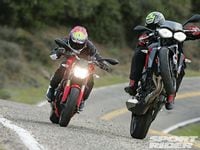
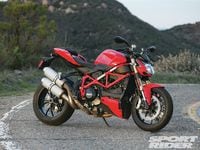
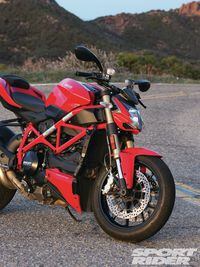
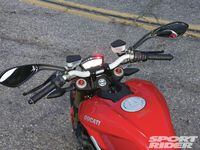
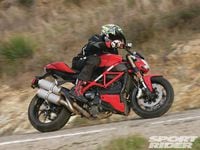
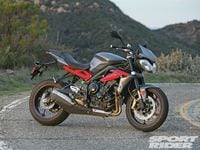
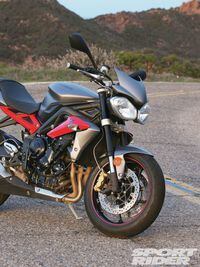
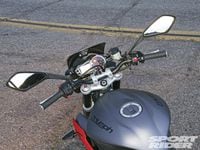
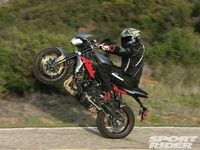
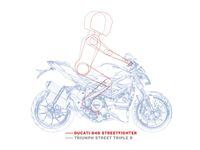
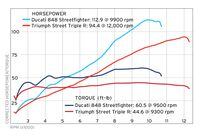

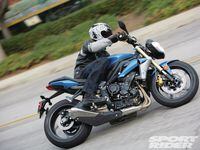
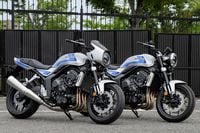

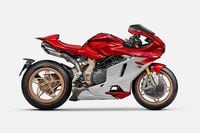
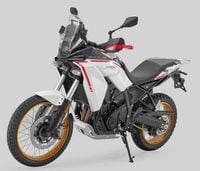

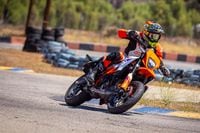
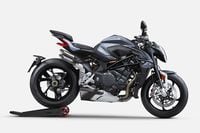
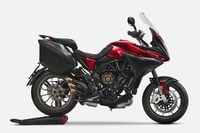
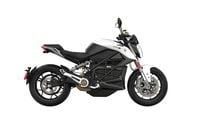
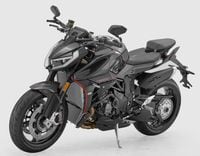




/cloudfront-us-east-1.images.arcpublishing.com/octane/URQMNYZZ6ZBM5LXGREBV3Y72OM.jpg)
/cloudfront-us-east-1.images.arcpublishing.com/octane/XH2ETEU4NVGDFNQO2XT2QQS5LU.jpg)
/cloudfront-us-east-1.images.arcpublishing.com/octane/DUGAQC2GQJCXFILEECQK2Q6T7I.jpg)
/cloudfront-us-east-1.images.arcpublishing.com/octane/4OGCCVR7WZGYDOWK4CGDTHXITA.jpg)
/cloudfront-us-east-1.images.arcpublishing.com/octane/GQV7Y6XT6FGZDIXO4P2IVJNSYE.jpg)
/cloudfront-us-east-1.images.arcpublishing.com/octane/X47GL62AXNALRHQLLBELY5WRMY.jpg)
/cloudfront-us-east-1.images.arcpublishing.com/octane/7OY2GP3FWFEDVEMDSLNGM6PZRM.jpg)
/cloudfront-us-east-1.images.arcpublishing.com/octane/Y3XYCFONBBBAHN6BWJDTWDY3FE.jpg)
/cloudfront-us-east-1.images.arcpublishing.com/octane/P3DLTISFGJA43L5QXVH7365UNY.jpg)
/cloudfront-us-east-1.images.arcpublishing.com/octane/H6FFG4YQMREO3DTADIJMECNS7Y.jpg)